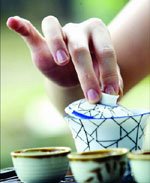 Just about every train car has at one end a hot water dispenser. And there are thermal carafes of hot water in each compartment for travelers to use. These are very handy - since food on the train is a little expensive; and most travelers prefer to bring their own instant noodle cups to eat on the train. And many travelers also bring their own travel cups - which they fill with hot water from time to time - to steep whatever kind of tea they happen to be drinking. Some people who travel as a group will even bring a piao-i cup and steep tea for the group.
Just about every train car has at one end a hot water dispenser. And there are thermal carafes of hot water in each compartment for travelers to use. These are very handy - since food on the train is a little expensive; and most travelers prefer to bring their own instant noodle cups to eat on the train. And many travelers also bring their own travel cups - which they fill with hot water from time to time - to steep whatever kind of tea they happen to be drinking. Some people who travel as a group will even bring a piao-i cup and steep tea for the group. secure it tightly. The interesting trick though, is to not scald your fingers as you open the tap on the dispenser. With the jerking movements of the train, it's kind of hard to not scald the fingers.
secure it tightly. The interesting trick though, is to not scald your fingers as you open the tap on the dispenser. With the jerking movements of the train, it's kind of hard to not scald the fingers. Each train seems to be different in how the water temperature is adjusted on those water dispensers. Some trains have a dispenser with a lower water temperature. When I traveled from Longyan, Fujian to Beijing, I brough along a really good packet of tieguanyin. And every steep just wasn't very good. The water temperature was too low.
But every time I traveled from Fuzhou or Longyan to Shenzhen, the water t
 emperature on that train was quite hot. And tieguanyin would steep nicely.
emperature on that train was quite hot. And tieguanyin would steep nicely.Whatever the train, don't expect the tea to taste as good as a round of gongfu tea. In fact, it's best to bring along a cheaper, but still quite nice kind of tea to enjoy on the train.
Of course, if you get bored, or if you get hungry, you can always go to the dining car, and check out what 
And if you're just not able to bring any tea or a travel tea cup, watch out for the snack cart. The girl comes around pretty regularly, and you can buy a bottle of iced tea or iced green tea. Of course, it's not really iced, and was never refrigerated. So don't expect a cold drink.
A bottle of tea typically costs 5 yuan. A noodle cup from the snack cart also costs 5 yuan.

A meal in the dining car is pricier. Expect each dish to run you about 35 yuan per dish. A bowl or two of rice is an extra cost.
And hot water from the water dispensers is free.
Train sta



No comments:
Post a Comment